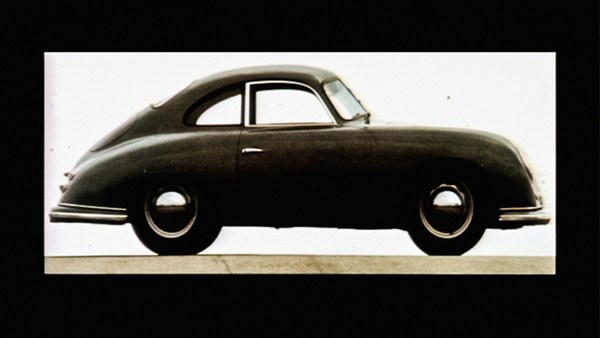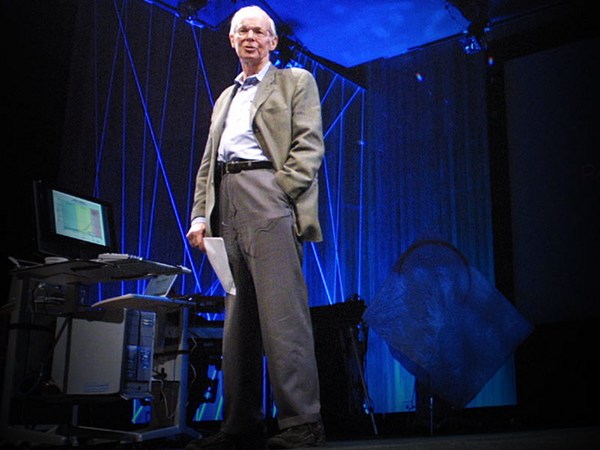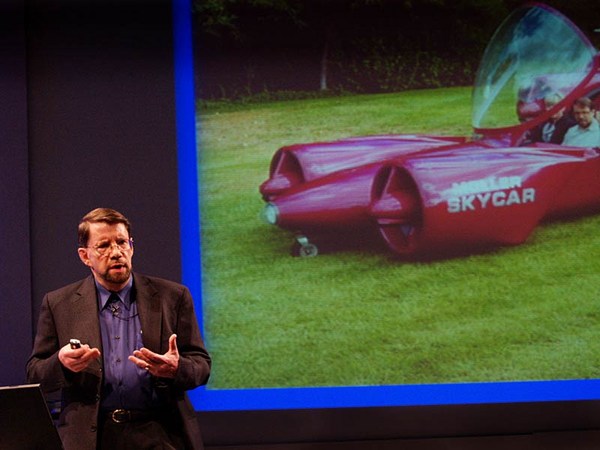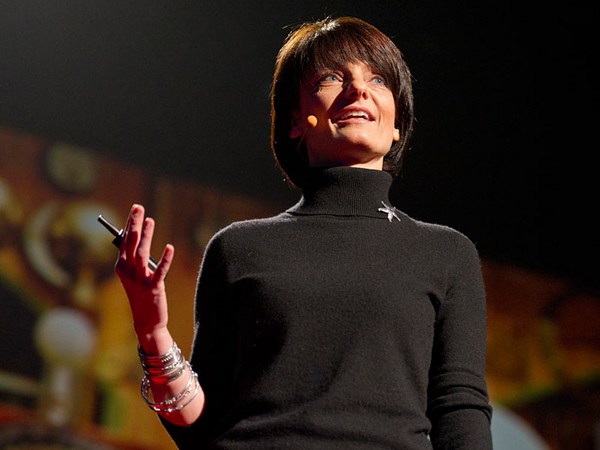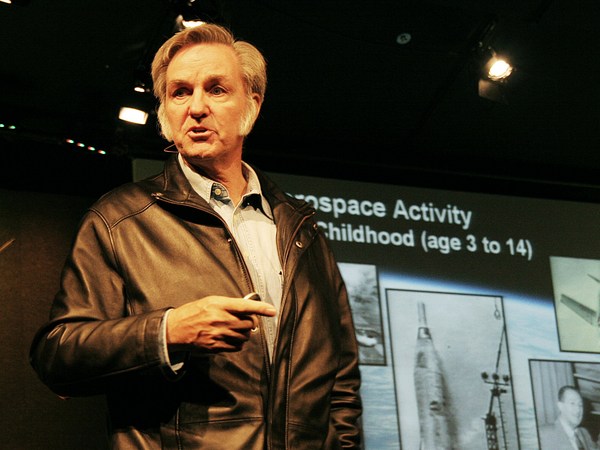Co je tak atraktivního na létajicích autech? Usilujeme o ně už alespoň sto let. A je tu několik historických pokusů, které z technologického hlediska slavily úspěch. Ale zatím jsme se nedostali do bodu, kdy byste ráno cestou sem viděli něco, co by opravdu skutečně a bezchybně spojovalo dvourozměrný svět, který je nám tak blízký, s trojrozměrnou oblohou nad našimi hlavami -- tedy nevím jak vy, ale já si opravdu užívám čas strávený tam nahoře.
What is it about flying cars? We've wanted to do this for about a hundred years. And there are historic attempts that have had some level of technical success. But we haven't yet gotten to the point where on your way here this morning you see something that really, truly seamlessly integrates the two-dimensional world that we're comfortable in with the three-dimensional sky above us -- that, I don't know about you, but I really enjoy spending time in.
Podívali jsme se na předchozí pokusy, které se na tomto poli uskutečnily, a uvědomili jsme si, že navzdory faktu, že dnes máme množství skvělých inovací, na kterých můžeme stavět a které předtím nebyly k dispozici -- máme moderní kompozitní materiály, máme letecké motory, které jsou úsporné a mají lepší poměr tahu a hmotnosti než měly kdykoli předtím, máme celoskleněné kokpity, které vám poskytují přesně ty informace, které k letu potřebujete, a to prostřednictvím rozměrných displejů -- ale bez zásadního přehodnocení celé problematiky z jiné perspektivy, bychom dosáhli pouze opět stejných výsledků, kterých lidé dosahovali během posledních sta let, což není právě výsledek, ke kterému bychom chtěli dospět. A tak namísto toho, abychom se snažili vytvořit auto, které může létat, rozhodli jsme se vytvořit letadlo, kterým můžete jezdit po silnici.
We looked at the historical attempts that had been out there and realized that, despite the fact that we have a lot of modern innovations to draw on today that weren't available previously -- we have modern composite materials, we have aircraft engines that get good fuel economy and have better power-to-rate ratios than have ever been available, we have glass cockpit avionics that bring the information you need to fly directly to you in the cockpit -- but without fundamentally addressing the problem from a different perspective, we realized that we were going to be getting the same result that people had been getting for the last hundred years, which isn't where we want to be right now. So instead of trying to make a car that can fly, we decided to try to make a plane that could drive.
A výsledkem je Terrafugia Transition. Je to dvoumístné jednomotorové letadlo, které funguje úplně stejně jako jakékoli jiné malé letadlo. Vzlétnete a přistanete na blízkém letišti. Pokud jste na zemi, sklopíte křídla, odjedete domů a zaparkujete ve své garáži. A funguje to. Po dvou letech navrhování a výroby si první prototyp odbyl své veřejné představení v roce 2008.
And the result is the Terrafugia Transition. It's a two-seat, single-engine airplane that works just like any other small airplane. You take off and land at a local airport. Then once you're on the ground, you fold up the wings, drive it home, park it in your garage. And it works. After two years of an innovative design and construction process, the proof of concept made its public debut in 2008.
Jako u čehokoli jiného, co je opravdu novátorské a narušuje status quo, ani zde neprobíhaly testy úplně přímočaře. A uvědomili jsme si, že mnohem užitečnější je, když něco nefunguje, protože se toho naučíte víc, než když vám jde všechno pěkně od ruky a podle plánu. V každém případě jsme opravdu hodně chtěli spatřit letadlo, které bychom společnými silami postavili a dostali do vzduchu. Aby vzlétlo, jak jsme to zamýšleli. Během třetího testu, kdy jsme ověřovali chování za vysokých rychlostí, bylo to jednoho chladného rána na severu New Yorku, se nám to poprvé povedlo. Obrázek za mnou pořídil pilot doprovodného letadla, okamžik po tom, co se kola úplně poprvé odlepila od země. Všechny nás tento obrázek ohromně potěšil, stal se symbolem dosažení toho, o čem si lidé po celém světě mysleli, že je nemožné.
Now like with anything that's really different from the status quo, it didn't always go so well testing that aircraft. And we discovered that it's a very good thing that, when you go home with something that's been broken, you've actually learned a lot more than when you managed to tick off all of your test objectives the first time through. Still, we very much wanted to see the aircraft that we'd all helped build in the air, off the ground, like it was supposed to be. And on our third high-speed testing deployment on a bitter cold morning in upstate New York, we got to do that for the first time. The picture behind me was snapped by the copilot in our chase aircraft just moments after the wheels got off the ground for the first time. And we were all very flattered to see that image become a symbol of accomplishing something that people had thought was impossible really the world over.
Následné letové testy byly tak prosté a bezpečné, jak jen to bylo možné, ale i tak jsme dosahovali všeho, co jsme potřebovali, abychom pokročili na další úroveň programu, a získali tak důvěryhodnost, kterou vyžaduje potenciální trh, letecké úřady, a všechny ty instituce, které dohlíží na konstrukce letadel, obzvláště zde ve Státech. Federální letecký úřad (FAA) přibližně před rokem udělil našemu Transitionu výjimku, čímž nám umožnil navýšit hmotnost o 50 kg v rámci kategorie lehkých sportovních letadel. To možná nezní jako moc, ale je to ohromně důležité, abychom mohli Transition dodávat v rámci kategorie lehkých sportovních letadel, což je pro nás jednodušší z hlediska certifikace, v neposlední řadě je to pak i jednodušší pro vás z hlediska létání. Sportovní pilot může získat certifikaci absolvováním 20 letových hodin. Proto těch 50 kg. Stejně tak důležité ale bylo vyřešit druhou stranu rovnice -- jízdu po silnici.
The flight testing that followed that was as basic and low-risk as we could make it, but it still accomplished what we needed to to take the program to the next step and to gain the credibility that we needed within our eventual market, the general aviation community, and with the regulators that govern the use of design of aircraft, particularly in the States. The FAA, about a year ago, gave us an exemption for the Transition to allow us to have an additional 110 lbs. within the light sport aircraft category. Now that doesn't sound like a lot, but it's very important, because being able to deliver the Transition as a light sport aircraft makes it simpler for us to certify it, but it also makes it much easier for you to learn how to fly it. A sport pilot can be certificated in as little as 20 hours of flight time. And at 110 lbs., that's very important for solving the other side of the equation -- driving.
Ukázalo se totiž, že jízda po silnici z hlediska návrhu, který zohledňuje veškeré regule a požadavky, je ve skutečnosti obtížnější problém než létání. Pro ty z nás, kdo tráví většinu svého života na zemi, to může být neintuitivní, ale na silnicích jsou výmoly, dlažební kostky, chodci, další řidiči a poměrně dlouhý a detailní seznam bezpečnostních opatření, která musí vozidla splňovat. Naštěstí, nutnost je matkou vynálezů, a tak hodně práce na návrhu, na kterou jsme na našem letadle nejvíce pyšní, vzešla z řešení problémů spojených s pohybem po zemi -- počínaje variátorem, přes kapalinové chlazení, které dovoluje použít letecký motor i během jízdy po zemi, až po vlastní typ převodovky, která pohání jak vrtuli, když letíte, tak i kola, když jedete po zemi, či skládací mechanismus křídla, který je automaticky složí, jak uvidíme za okamžik, a různé bezpečnostní vybavení. Máme šasi z uhlíkových vlákem, která chrání pasažéry, a to při méně než 10procentní hmotnosti běžné ocelové šasi aut.
It turns out that driving, with its associated design implementation and regulatory hurdles, is actually a harder problem to solve than flying. For those of us that spend most of our lives on the ground, this may be counter-intuitive, but driving has potholes, cobblestones, pedestrians, other drivers and a rather long and detailed list of federal motor vehicle safety standards to contend with. Fortunately, necessity remains the mother of invention, and a lot of the design work that we're the most proud of with the aircraft came out of solving the unique problems of operating it on the ground -- everything from a continuously-variable transmission and liquid-based cooling system that allows us to use an aircraft engine in stop-and-go traffic, to a custom-designed gearbox that powers either the propeller when you're flying or the wheels on the ground, to the automated wing-folding mechanism that we'll see in a moment, to crash safety features. We have a carbon fiber safety cage that protects the occupants for less than 10 percent of the weight of a traditional steel chassis in a car.
To ale, navzdory tomu, jak skvělé to je, nestačilo. Předpisy pro pozemní vozidla nebyly psány s ohledem na letadla. A tak jsme potřebovali trochu podpory od Národního úřadu pro bezpečnost provozu. Mohli jste tak ve zprávách vidět, že pro nás vystavili koncem minulého měsíce pár zvláštních výjimek, které umožní prodávat Transition ve stejné kategorii jako vozidla SUV a menší nákladní vozy. Jako víceúčelové osobní vozidlo, které je „navrženo pro příležitostnou jízdu mimo silnici".
Now this also, as good as it is, wasn't quite enough. The regulations for vehicles on the road weren't written with an airplane in mind. So we did need a little bit of support from the National Highway Traffic Safety Administration. Now you may have seen in the news recently, they came through with us at the end of last month with a few special exemptions that will allow the Transition to be sold in the same category as SUVs and light trucks. As a multi-purpose passenger vehicle, it is now officially "designed for occasional off-road use."
(Smích)
(Laughter)
Podívejme se na to v akci. Vidíte křídla složená podél trupu letadla. Nepoháníme teď vrtuli, ale kola. Na výšku má méně než 2 metry, takže se vejde do běžné garáže. A tohle je zmíněný mechanismus pro automatické sklápění křídel. Záznam není zrychlený. Jednoduše v kabině zmáčknete pár tlačítek a křídla se zase rozloží. A jakmile jsou roztažena, zajistíte je mechanickým zámkem, opět zevnitř kabiny. A poté jsou schopna zcela zvládat všechny vlivy, kterým budou vystavena za letu -- je to jako stažení střechy u vašeho kabrioletu. Určitě si všichni říkáte, co si pomyslí vaši sousedé, když to uvidí.
Now let's see it in action. You can see there the wings folded up just along the side of the plane. You're not powering the propeller, you're powering the wheels. And it is under seven feet tall, so it will fit in a standard construction garage. And that's the automated wing-folding mechanism. That's real time. You just push a few buttons in the cockpit, and the wings come out. Once they're fully deployed, there's a mechanical lock that goes into place, again, from inside the cockpit. And they're now fully capable of handling any of the loads you would see in flight -- just like putting down your convertible top. And you're all thinking what your neighbors would think of seeing that.
(Video) Zkušební pilot: Dokud stroj nevzlétne, 75 procent rizika tkví v prvním letu.
(Video) Test Pilot: Until the vehicle flies, 75 percent of your risk is that first flight.
Rádio: Opravdu letí. Ano.
Radio: It actually flew. Yes.
Rádio 2: To bylo ohromné.
Radio 2: That was gorgeous.
Rádio: Jak to na Tebe působilo? Musím vám říct, že to odtam shora bylo nádherné.
Radio: What did you think of that? That was beautiful from up here, I tell you.
AMD: Vidíte, všichni jsme mimořádně nadšeni tímto malým skokem. A náš zkušební pilot nám dal tu nejlepší zpětnou vazbu, jakou můžete od zkušebního pilota po prvním letu dostat, což bylo, že let byl „pozoruhodně běžný". Také nám řekl, že s Transitionem se přistávalo nejlépe ze všech letadel, se kterými za svou 30letou kariéru zkušebního pilota letěl. Takže namísto vytvoření něčeho, co je zdánlivě revoluční, jsme se soustředili na to, abychom vytvořili nového tak málo, jak jen to bylo možné. Využili jsme mnoho špičkových technologií ze všeobecného letectví a automobilového sportu. A když pracujeme na něčem zcela novém, postupujeme v malých krocích, vytvoříme, ověříme, přetvoříme a tak dále, což nám dovoluje umenšit riziko už během prvních kroků.
AMD: See, we're all exceedingly excited about that little bunny hop. And our test pilot gave us the best feedback you can get from a test pilot after a first flight, which was that it was "remarkably unremarkable." He would go onto tell us that the Transition had been the easiest airplane to land that he'd flown in his entire 30-year career as a test pilot. So despite making something that is seemingly revolutionary, we really focused on doing as little new as possible. We leverage a lot of technology from the state-of-the-art in general aviation and from automotive racing. When we do have to do something truly out-of-the-box, we use an incremental design, build, test, redesign cycle that lets us reduce risk in baby steps.
Když jsme založili Terrafugiu před nějakými 6 lety, těchto malých kroků jsme dělali velké množství. Postupně jsme vyrostli ze tří lidí, co pracovali ve sklepě na MIT, zatímco stále studovali, do skupiny dvou tuctů lidí, kteří pracují na počáteční produkci v továrně poblíž Bostonu. Museli jsme překonat překážky jako je dodržení hmotnosti pro kategorii sportovních letadel, o čem jsem mluvila, vyřešit, jak zdvořile odpovědět, když nám úředník řekne: „Ale tohle s roztaženými křídly neprojede mýtnou branou" -- (Smích) až po všechny ty pevnostní překážky spojené s konstrukcí, jak jsme se o tom zmínila v souvislosti s jízdou po zemi. Takže pokud půjde všechno k naší spokojenosti, ať už v případě zkoušek nebo konstrukce obou našich prototypů, na kterých v současnosti pracujeme, první dodávky přibližně stovce zákazníků, kteří si letadlo dosud rezervovali, by mohly začít koncem příštího roku.
Now since we started Terrafugia about 6 years ago, we've had a lot of those baby steps. We've gone from being three of us working in the basement at MIT while we were still in graduate school to about two-dozen of us working in an initial production facility outside of Boston. We've had to overcome challenges like keeping the weight below the light sport limit that I talked about, figuring out how to politely respond when a regulator tells you, "But that won't fit through a toll booth with the wings extended -- (Laughter) to all of the other associated durability and engineering issues that we talked about on the ground. Still, if everything goes to our satisfaction with the testing and construction of the two production prototypes that we're working on right now, those first deliveries to the, about a hundred, people who have reserved an airplane at this point should begin at the end of next year.
Transition bude stát stejně jako ostatní malá letadla. Rozhodně si nemyslím, že by nahradil váš Chevrolet, ale myslím si, že by Transition mohl být vaším příštím letadlem. Tady je důvod. Zatímco téměř všechna komerční letecká přeprava ve světě funguje prostřednictvím relativně malého množství uzlových letišť, je tu ohromné množství nevyužitých menších letišť. Existují tisíce regionálních letištních ploch, které zdaleka nedosahují denních pohybů, kterých by mohly. Průměrně je jedna taková plocha každých 30 až 50 km, ať už jste ve Spojených státech kdekoli. Transition vám nabízí bezpečnější, pohodlnější a zábavnější způsob, jak tyto možnosti využít.
The Transition will cost in line with other small airplanes. And I'm certainly not out to replace your Chevy, but I do think that the Transition should be your next airplane. Here's why. While nearly all of the commercial air travel in the world goes through a relatively small number of large hub airports, there is a huge underutilized resource out there. There are thousands of local airstrips that don't see nearly as many aircraft operations a day as they could. On average, there's one within 20 to 30 miles of wherever you are in the United States. The Transition gives you a safer, more convenient and more fun way of using this resource.
Pro ty z vás, kdo zatím nejsou piloty, existují čtyři hlavní důvody, proč my, kdo piloty jsme, nelétáme tak často, jako bychom chtěli: počasí, to v prvé řadě, náklady, dlouhá cesta z domu na letiště a zpět, a omezená mobilita v cíli cesty. Ale teď, když přijde špatné počasí, prostě přistanete, složíte křídla, odjedete domů. Nezáleží na tom, jestli prší, protože máte stěrač. Namísto toho, abyste platili za hangárování letadla, parkujete jej ve své garáži. A bezolovnaté automobilové palivo, které používáme, je jak levnější, tak i ekologičtější než běžný Avgas. Cesta z domu na letiště a zpět je zkrácena, protože se nemusíte starat o kufry, hledat parkovací místo, sundávat si boty na bezpečnostní kontrole, vytahovat letadlo z hangáru, teď už trávíte čas pouze cestou tam, kam chcete. A mobilita v místě, kam docestujete, je jednoduše vyřešena. Jen sklopíte křídla a pokračujete.
For those of you who aren't yet pilots, there's four main reasons why those of us who are don't fly as much as we'd like to: the weather, primarily, cost, long door-to-door travel time and mobility at your destination. Now, bad weather comes in, just land, fold up the wings, drive home. Doesn't matter if it rains a little, you have a windshield wiper. Instead of paying to keep your airplane in a hanger, park it in your garage. And the unleaded automotive fuel that we use is both cheaper and better for the environment than traditional avgas. Door-to-door travel time is reduced, because now, instead of lugging bags, finding a parking space, taking off your shoes or pulling your airplane out of the hanger, you're now just spending that time getting to where you want to go. And mobility to your destination is clearly solved. Just fold up the wings and keep going.
Transition zároveň rozšiřuje naše obzory a přitom zmenšuje svět, dělá z něj dostupnější místo. A v neposlední řadě jde o báječné dobrodružství. Doufám, že se všichni alespoň na chvíli zamyslíte, jak by vám mohlo použití tohoto prostředku pomoci, abyste získali lepší přístup k vlastnímu světu, a abyste své cestování učinili pohodlnějším a zábavnějším.
The Transition simultaneously expands our horizons while making the world a smaller, more accessible place. It also continues to be a fabulous adventure. I hope you'll each take a moment to think about how you could use something like this to give yourself more access to your own world, and to make your own travel more convenient and more fun.
Děkuji, že jste mi dali příležitost toto vše s vámi sdílet.
Thank you for giving me the opportunity to share it with you.
(Potlesk)
(Applause)
